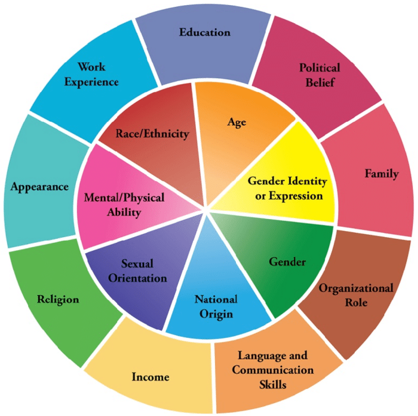DIVERSITY WHEEL

|
The diversity committee at Family & Children’s Center would like to start sharing different resources with you to read, consider, and discuss about different aspects of diversity each month. Our goal is “To facilitate discussions about diversity by building awareness and understanding, uniting staff, and enhancing the inclusivity of all within the organization and communities we serve.” With that in mind, our plan is to share a monthly resource for you to consider to help initiate and maintain diversity conversations. This month we chose to share the Diversity Wheel, which was developed by Johns Hopkins University. This wheel was developed to help people learn about internal and developmental processes that lead a person to be inclusive. |
|
Simply put, diversity means difference. Often this difference is tied to social justice, but that is not what the Diversity Wheel is about. It is meant for your own self-reflection and your own interpretation of how you view differences in others. As you can see in the graphic above, the Diversity Wheel includes the following types of diversities: age, gender identity or expression, gender, national origin, sexual orientation, mental/physical ability, race/ethnicity, education, political belief, family, organizational role, language/communication skills, income, religion, appearance, and work experience. As you can tell, some of these levels of diversity are visible, while others are less apparent. It is important for each of us to understand our own level of comfort with each of these various traits of diversity. Some people are just naturally more comfortable with a diverse group of people than others. Some of us want to learn to be more comfortable with diversity. This leads us to many questions. When we encounter a person who is different from us, what meaning are we ascribing to that difference? How do we interpret the differences? How and when did we develop these interpretations of the differences? Where are our own blind spots? |
|
All of these important questions may spark some self-reflection for many of us. A great place to start on your own diversity journey is to pick some areas of diversity, which are comfortable for you, and list a few reasons why this difference is not difficult for you. After you do that self-reflection, consider what types of diversity you are less comfortable with. This may be because that the difference is unknown to you or confusing. List a few reasons why this might be your reaction. |
|
Hopefully this simple exercise helps you to think a little more closely about your own awareness of diversity and your response to others. Through this awareness we can start to build a more inclusive life. We would like to invite anyone who is interested to join the diversity committee to discuss your findings and to continue to unpack the different levels of diversity that exist. The diversity committee meets the first Tuesday of every month at noon through zoom. So, for next month, we will be meeting at 12:00 pm on August 3rd. If you are interested in discussing what you learned about yourself and where we should continue to take our diversity dialogues, here at Family & Children’s Center, we would love to have you join us! Please contact Leah at lmorken@fccnetwork.org if you are interested or if you have ideas for resources you would like us to share with everyone. Looking forward to seeing you next month! |